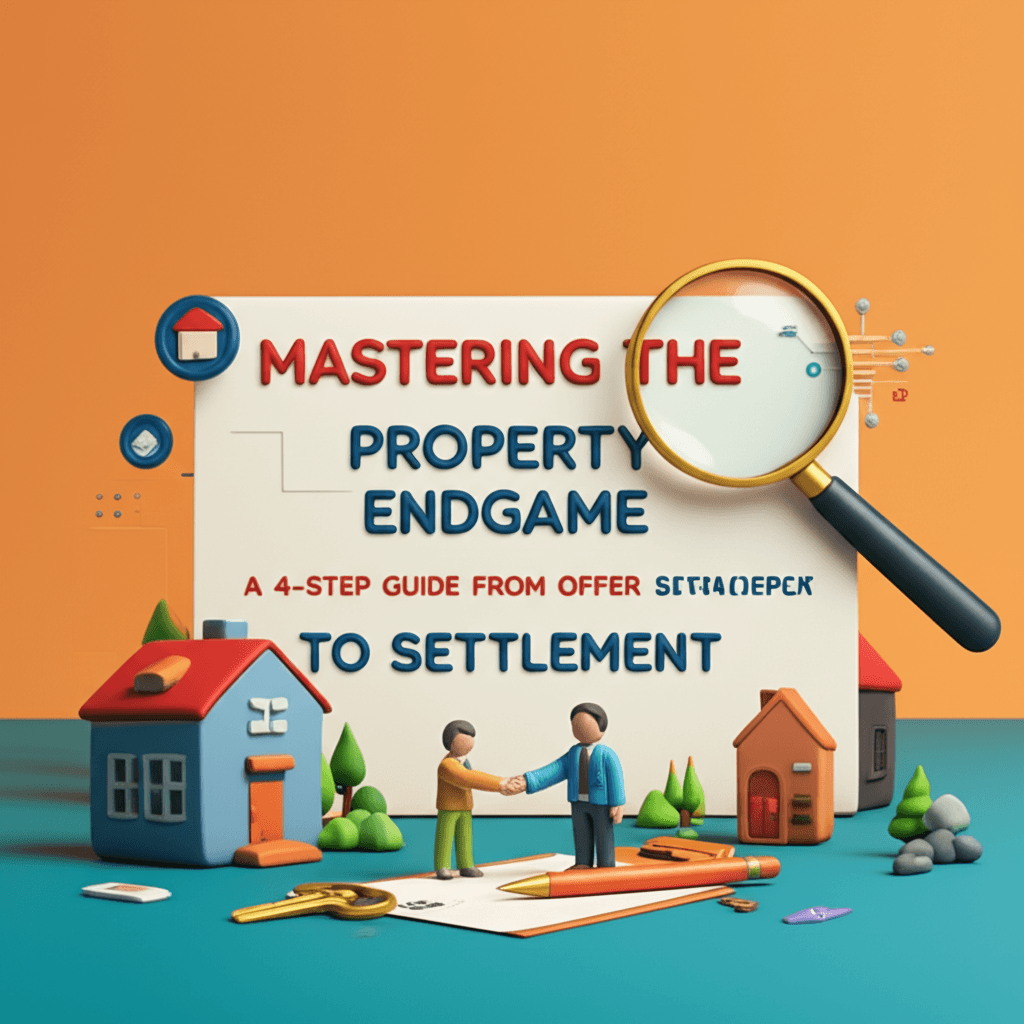Mastering the Property Endgame: A 4-Step Guide From Offer to Settlement
Navigate the complex journey from contract to keys with confidence. Learn how to take control and avoid common pitfalls in the Australian property market.

Introduction
For many aspiring property investors, the journey from finding the perfect property to finally holding the keys can feel like a maze of legal jargon and high-stakes decisions. This period, from making an offer to the final settlement, is often filled with 'unknown unknowns' that can lead to costly mistakes. The key to success is understanding that this process is a strategic negotiation, much like a game of tennis. Your goal is to take control of the ball—the property—and keep it in your court.

The Four Key Steps from Offer to Settlement
Navigating the purchase process can be broken down into four distinct stages. By mastering the first two, you set yourself up for a smooth and successful settlement, transforming a potentially stressful experience into a calculated investment move.
Step 1: Making a Strategic Offer
This is where you serve the ball and begin to gain control. An offer isn't just a price; it's a package of terms that includes the purchase price, deposit amount, settlement period, and any special conditions. To make your offer compelling, you need to create urgency.
Craft a Strong Offer: Your terms should be attractive to the vendor, but always serve your strategy. For example, if you plan to renovate, you might request access for trades to provide quotes between the contract going unconditional and settlement.
Create Urgency: A common mistake buyers make is submitting an open-ended offer. This allows the agent to use your offer to solicit higher bids from others. Instead, attach a deadline to your offer, implying you are looking at other properties. This pressures the agent to return the ball to you quickly.
Gain Control: Once your offer is made, the negotiation begins. The back-and-forth continues until you and the vendor agree on the final price and terms. The moment you reach a verbal agreement, it's time to move immediately to the next step to lock it in.
Step 2: The Critical Contract Exchange
An offer is not legally binding until the contract of sale is signed by both you and the vendor (fully executed). This is the most crucial phase for securing the property and protecting your interests. Until the contract is exchanged, another buyer can swoop in and gazump you.
Secure the Deal: Push to have the contract signed by the vendor as quickly as possible. An agent’s verbal confirmation of acceptance means nothing until the ink is dry. The deal is not yours until it is fully executed.
Use 'Get Out of Jail Free' Clauses: To move fast and secure a property while still performing thorough checks, smart investors use conditional clauses. The most common are:
Finance Clause: Typically 14-21 days, this allows you to exit the contract without penalty if you cannot secure finance.
Building and Pest Inspection Clause: This gives you a period to have the property professionally inspected. If significant issues are found, you can exit the contract or, more strategically, renegotiate the price.
State-Specific Rules: Be aware that property laws vary by state. For instance, some states have mandatory cooling-off periods, while others do not. Using a pest and building clause is often preferable to a cooling-off period, as exiting during a cool-off can incur a financial penalty (often 0.25% of the purchase price).

Step 3: Going Unconditional
Once your conditions (like finance and building inspections) have been met, the contract goes unconditional. This is the point of no return. If you pull out now, you will likely lose your deposit and could even face legal action. However, this period leading up to settlement is a golden opportunity for preparation.
While you don't own the property yet, you have secured it. Use this time—often a few weeks—productively:
Line Up Trades: If you negotiated access, get tradespeople through the property to provide accurate quotes for any planned work.
Engage a Property Manager: Have them inspect the property to advise on necessary updates to make it rent-ready and to begin searching for a suitable tenant.
Plan Your Timeline: Schedule painters, plumbers, and other services to start work the day after settlement. This minimises vacancy periods and holding costs, saving you thousands in the long run.

Step 4: The Settlement Day
Contrary to popular belief, settlement day is often the most underwhelming part of the process. It’s an administrative finish line where lawyers and banks exchange documents and funds. There are no grand ceremonies—you simply get an email from your conveyancer confirming it's done, and then you can collect the keys from the real estate agent.
A smooth settlement day is not a matter of luck; it's the direct result of the meticulous preparation and strategic control you established in steps one, two, and three. By front-loading all the effort, the final step becomes a simple, hassle-free handover.
Conclusion
The journey from offer to settlement is where a good property deal can become a great one—or a nightmare. The key is to take control early, understand your contractual rights, and use the time strategically. By focusing your energy on crafting a sharp offer and navigating the contract exchange with protective clauses, you turn the process from a game of chance into a well-executed play. The real work happens long before settlement day, ensuring that when you finally get the keys, you're already steps ahead.
Ready to navigate your property purchase with confidence? Discover how the HouseSeeker AI Buyer's Agent can guide you every step of the way.
Frequently Asked Questions
What is 'gazumping' and how can I avoid it?
'Gazumping' occurs when a seller accepts your verbal offer but then sells the property to someone else who makes a higher offer before contracts are formally exchanged. The best way to avoid it is to have the contract signed by both parties as quickly as possible after your offer is verbally accepted. Until the contract is fully executed, the property is still technically on the market.
What's the difference between a cooling-off period and a building and pest clause?
A cooling-off period is a statutory right in some states that allows a buyer a few business days to withdraw from a contract after it's signed. However, withdrawing often requires you to pay a penalty. A building and pest clause is a specific condition you add to the contract that allows you to withdraw without penalty if you are not satisfied with the inspection reports. It gives you more time and a more specific reason to exit the deal if necessary.
Can I do any work on the property before settlement?
Generally, no. You do not own the property until settlement is complete. However, you can and should negotiate a special condition in your contract that grants you access to the property before settlement for specific purposes, such as allowing tradespeople to measure and provide quotes. This allows you to hit the ground running the moment you take ownership.
